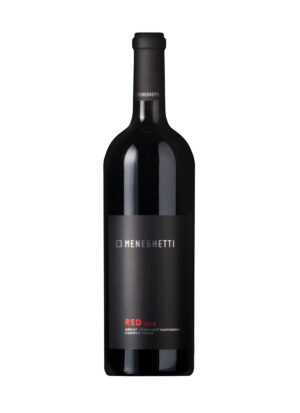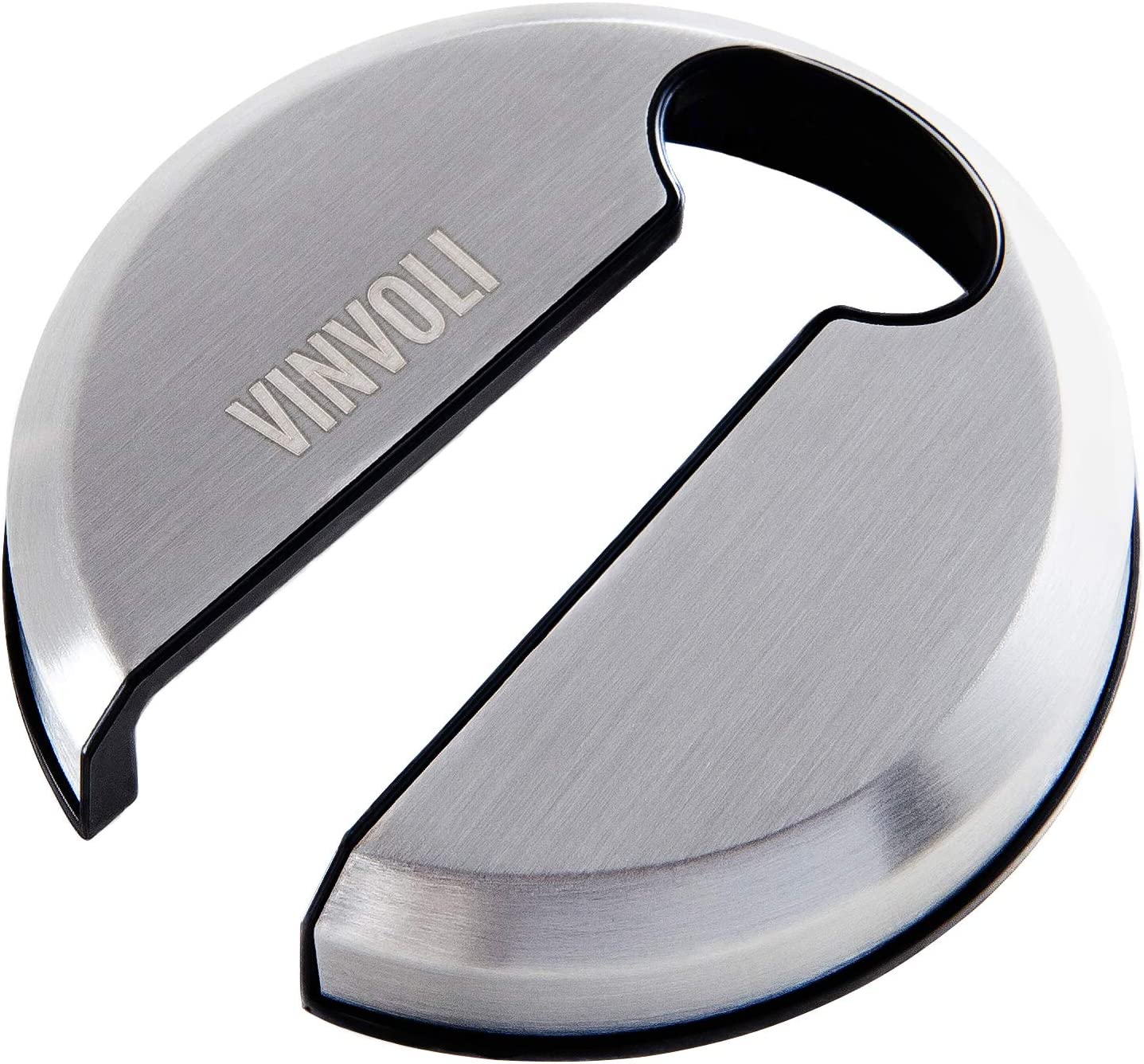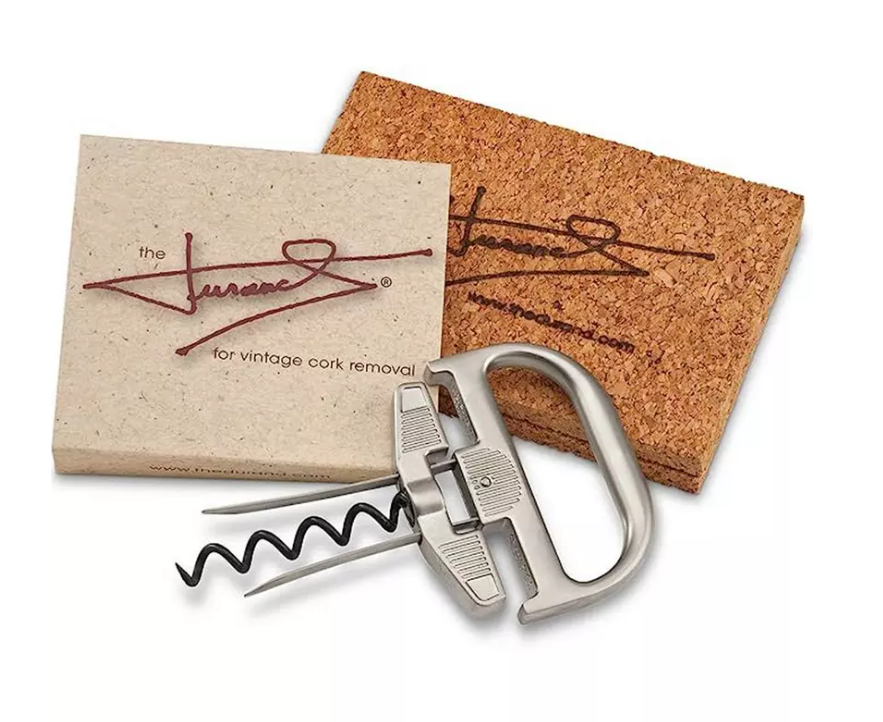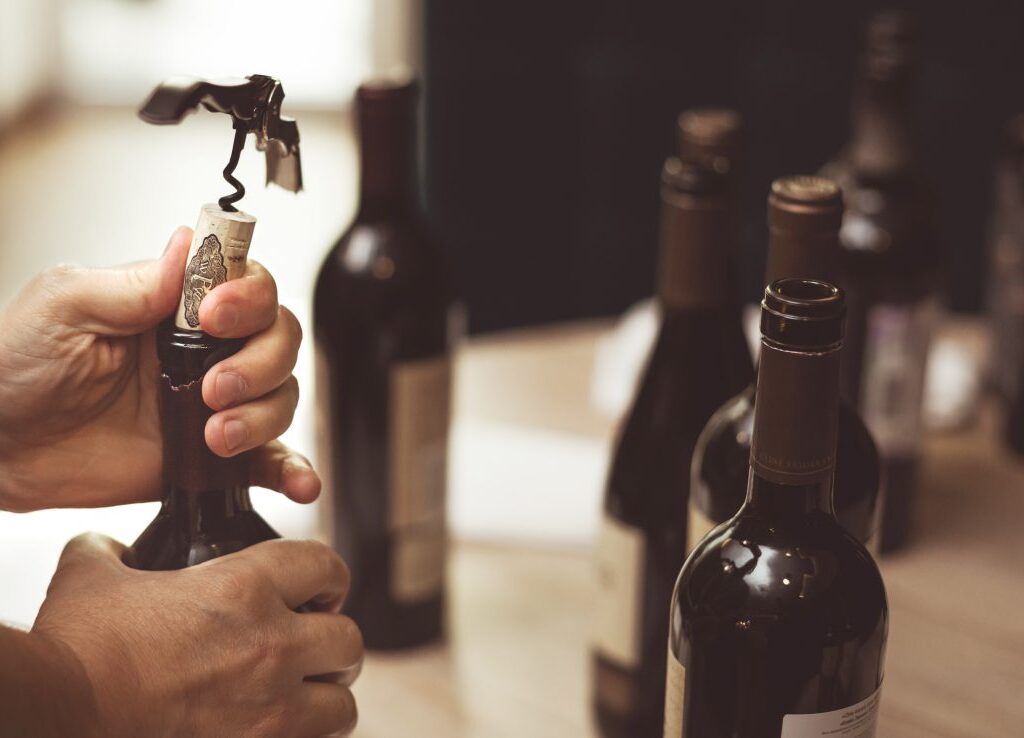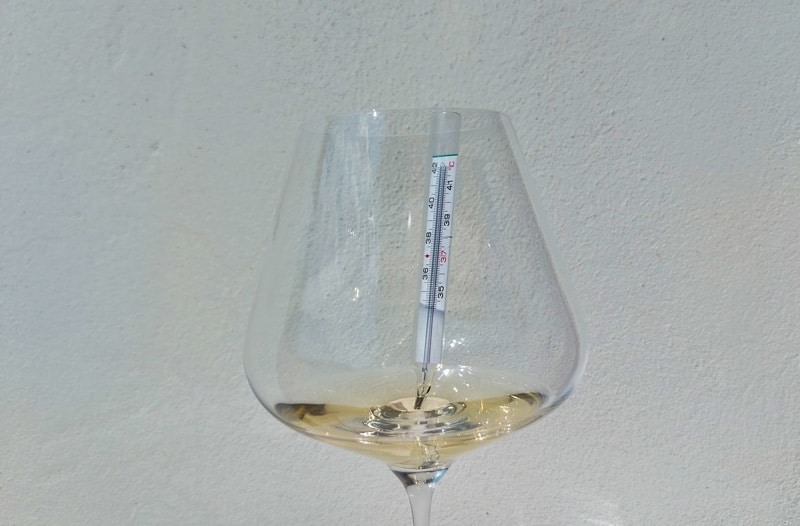5 Easy Steps: How To Open A Bottle Of Wine Like A Pro
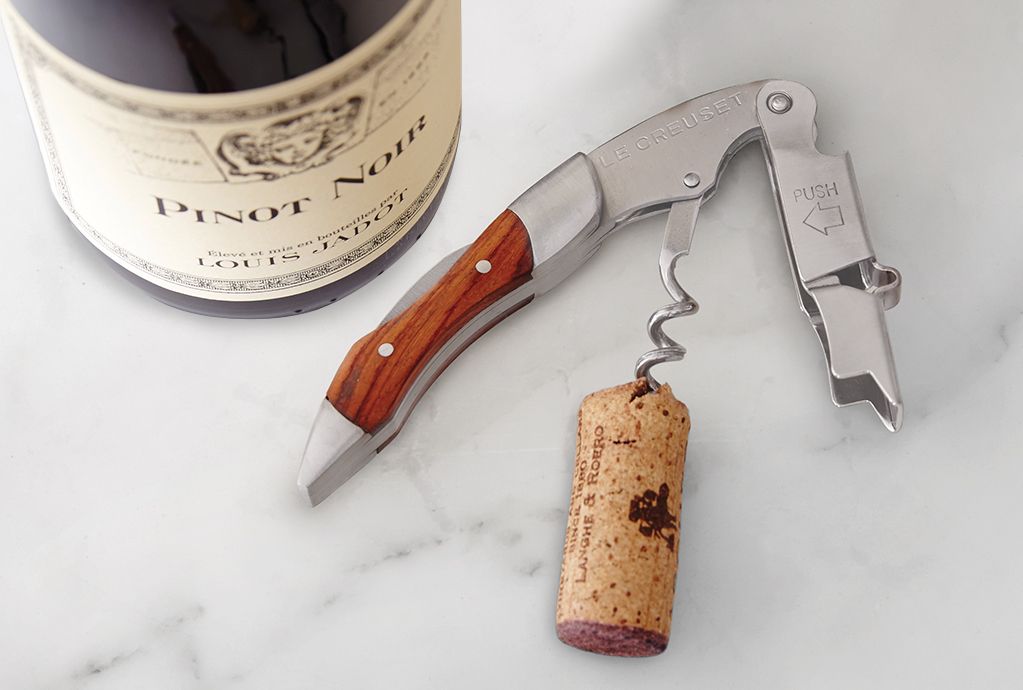
Knowing how (not) to open a bottle of wine properly is a skill that sets wine lovers and wine drinkers apart! It might seem like a simple task, but doing it like a pro requires certain skills and understanding of how to choose the best wine opener. A waiter’s corkscrew, also known as a wine key, is the most popular tool for this job. If you want to open the wine correctly, it’s crucial to start by removing the foil seal properly and then using the right technique to pull out the cork without making a mess. We prepared a step-by-step guide that includes removing the capsule, inserting the corkscrew at just the right angle, leveraging out the cork smoothly for clean removal, and finally pouring the wine in such a way that enhances its aroma. Moreover, if you find yourself without a corkscrew, there are alternative methods to get that bottle open and tips for dealing with vintage and aged wines and their delicate corks. Mastering these steps can make all the difference. Let’s explore how you can achieve a pro level in opening the wine!
5 easy steps for opening a bottle of wine like a pro
Follow these 5 steps to ensure a successful wine bottle opening experience:
- Remove the Foil or Capsule: Begin by removing the foil or capsule covering the cork. Using a knife or foil cutter. Make a clean cut just below the lower lip of the bottle to expose the cork fully.
- Insert the Corkscrew: Position the tip of the corkscrew at the center of the cork. Apply gentle pressure and twist the corkscrew clockwise until the screw is fully embedded in the cork.
- Rotate the Corkscrew: With the corkscrew securely in place, rotate it approximately six half turns to ensure a firm grip on the cork.
- Leverage the Cork Out: Utilizing the lever arm of the corkscrew, slowly and steadily lift the cork upwards. Maintain control and apply even pressure to prevent the cork from breaking or crumbling.
- Final Touch: After removing the cork, inspect the neck of the bottle for any cork leftovers. Use a clean napkin or cloth, and gently wipe away any residue to ensure a pristine pour.
For those who are visually inclined, check out the video on how to master the art of opening a wine bottle correctly.
Wine accessories required to open a bottle of wine
To open a bottle of wine like a pro, you need a specific set of wine accessories. We strongly recommend using a waiter-style corkscrew or wine key along with a foil cutter.
Waiter-style corkscrew or wine key
|
$19.50
|
$18.25
|
We all agree, that having the right wine accessories or wine gadgets makes opening a bottle of wine much easier and more enjoyable. Among those tools, the waiter-style corkscrew stands out as a champion. It’s not just popular. Its a simple and effective method for bottle opening, trusted and used by professionals worldwide.
Wine corkscrews come with a small knife to remove the wine foil and capsule seamlessly, followed by a worm—or screw—that’s precisely engineered to pierce the cork without damaging it.
Its built-in lever offers significant advantage, allowing us to extract even the most stubborn corks smoothly.
Using this corkscrew involves mastering a simple yet elegant technique. First, we use the attached knife to cut around the top edge of the capsule, revealing the cork underneath. Then, gently inserting the worm into the center of the cork ensures that when we lift using one notch of leverage—and then switch to another if needed—the cork glides out effortlessly and intact. This method avoids any unwanted pieces of cork getting into our wine.
Foil cutter
Effortlessly remove foil with a simple turn, ensuring a clean and precise result. This elegant and practical tool comes with a lifetime warranty, making it a lasting essential for wine lovers.
A foil cutter is a handy tool primarily used to remove the foil or capsule covering the cork of a wine bottle. It typically consists of a circular blade or blades enclosed in a housing.
To use it, you place the foil cutter on top of the bottle’s neck, squeeze the sides, and twist it to cut and remove the foil neatly and safeely.
There are various types of foil cutters available, ranging from
- simple handheld foil cutters,
- more sophisticated foil cutter models with multiple blades, and
- foil cutters integrated into unique wine accessories gif sets for enthusiasts who want to upgrade their wine experience.
Step-by-step guide to opening a wine bottle
We always start with the wine bottle in hand, showing it off or presenting it to our guests. Before opening the bottle, a good sommelier or wine enthusiast would briefly present the main information about the wine:
- the name of the wine, it could be a fantasy name, or it could be named after a variety, etc.
- the variety, or the varieties of the wine, preferably with a short explanation if it is an unknown local variety etc., perhaps the position where the vine is grown
- the producer, including essential information about the winery, where it is from or about the enologist or the winemaker, etc.
- the vintage and general features of the harvest, if it’s relevant
Whereas food is usually served from the left, the sommelier will most probably serve from the right. While doing that, he would turn the label forward to make it visible to the person ordering the wine. The sommelier always does that to ensure the correct bottle is being served.
Even if you are having a casual dinner with friends, you’ll see that your guests love to know more about the wine you are serving. It is pretty common today to leave the bottle for your guest to take a snapshot with a phone camera.
The presentation doesn’t have to be as official as in top restaurants. Rather share your insight and, ideally, passion about the particular wine and what makes this wine special for you.
If this is the winery where you have been, describe your experience and tell people more. Sharing your emotions and impressions will enhance the feeling of enjoying the same bottle with your friends.
Step 1. Remove the foil or capsule
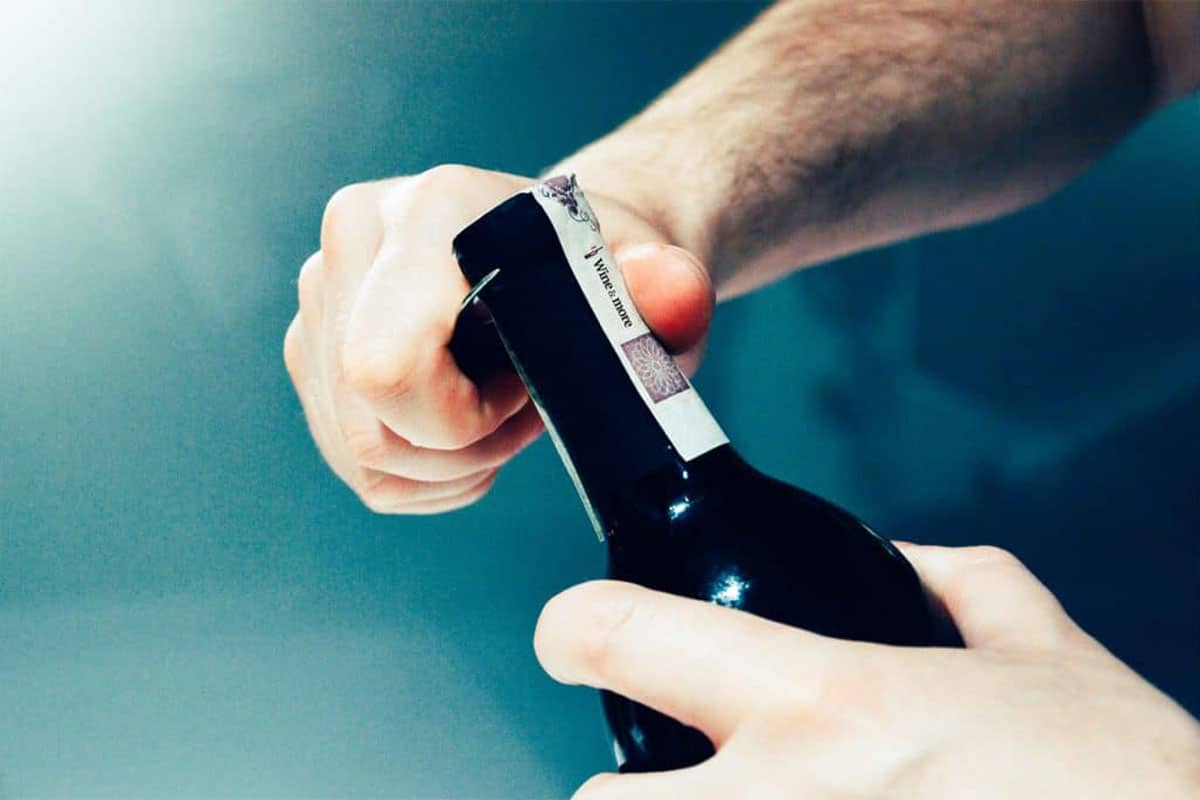
After presenting the wine bottle, our next move is to remove the capsule. Most fine wines come with a capsule, also known as the foil, which is a protective cover that sits on top of the wine bottle’s cork and neck. It serves as a barrier to protect the cork and wine from dirt, dust, and moisture.
For removing the capsule, it is best to use the specialized foil cutters or, as the sommeliers would do, use the small knife attached to the wine opener. It’s essential to cut around the bottom of this covering right under the little glass lip that sits at the top of most bottles.
Using a foil cutter makes this task effortless and neat. You don’t want to play spin the bottle. If you want to look like a pro, remember that the label should always be facing the guests.
Carefully positioning your foil cutter just underneath that lip allows you to apply even pressure as you twist it around. A smooth, circular motion works best here. With just a couple of turns, you’ll feel when it’s completely cut through.
At this point, lift off the top portion of the capsule to reveal clear access to the cork itself.
This method not only maintains a professional appearance but also prevents any possible tearing or jagged edges that might interfere with the cork removal downline or spoil some aspect of your wine-opening presentation.
Some foils are easier to remove than others. It depends mostly on the material used to make wine bottle capsules:
- PVC: Most common because it is also the cheapest material. It is easy to use and very lightweight. It also comes in all the possible colors to match the desired visual appearance of the bottle.
- Tin: Popular choice which today is used on more expensive bottles. It is heavier, and it crumples, unlike the plastic foil.
- Polylaminate: Material made of several layers of polymers, often including aluminium, to protect against oxygen and light.
- Aluminium: Used with increasingly popular screw caps, but in this case, the bottle is opened by hand, keeping the lower part of the cap under the perforations fixed and turning the wine bottle with the other hand. The cork will release itself, and the wine is immediately opened.
- Wax Capsules: Usually aren’t really made out of beeswax. Luckily, otherwise, the opening of the bottle could present a tiresome task. Mostly, an artificial wax is used that peels off quite easily.
After removing the foil top, put it in your pocket and be aware that nothing should touch the table, not even the bottle, during the wine presentation. The next step is cleaning the upper part of the bottle for the first time with the napkin to remove any possible dust or mold.
Step 2. Inserting the corkscrew
There is a reason why the most widely used wine opener in the world is “the waiter’s friend” or waiter corkscrew. Designs may vary depending on the producer, but it usually has everything you will need 99% of the time:
- attached small knife,
- a two-notch lever,
- and a screw (the “worm”, the spiral).
The procedure with the world’s most popular wine opener is as follows:
- place the wine bottle on a flat, stable surface,
- open the corkscrew and insert the screw straight into the middle of the cork,
- gently push it in, then begin twisting the handles clockwise,
- fully extend the waiter’s corkscrew so that the handle and lever are horizontal on each side.
Additional preparations and tools might be required if you end up opening seriously old or vintage wine. Extra care is required to avoid damaging the cork or the wine inside. Instead of a traditional corkscrew with a worm and a lever consider using an ah-so wine opener or a Durand, both designed to gently remove old and fragile corks.
A popular wine tool among wine enthusiasts, collectors, and sommeliers, this patented two-part device effortlessly removes old and fragile wine corks whole and undamaged.
Step 3. Rotate the Corkscrew
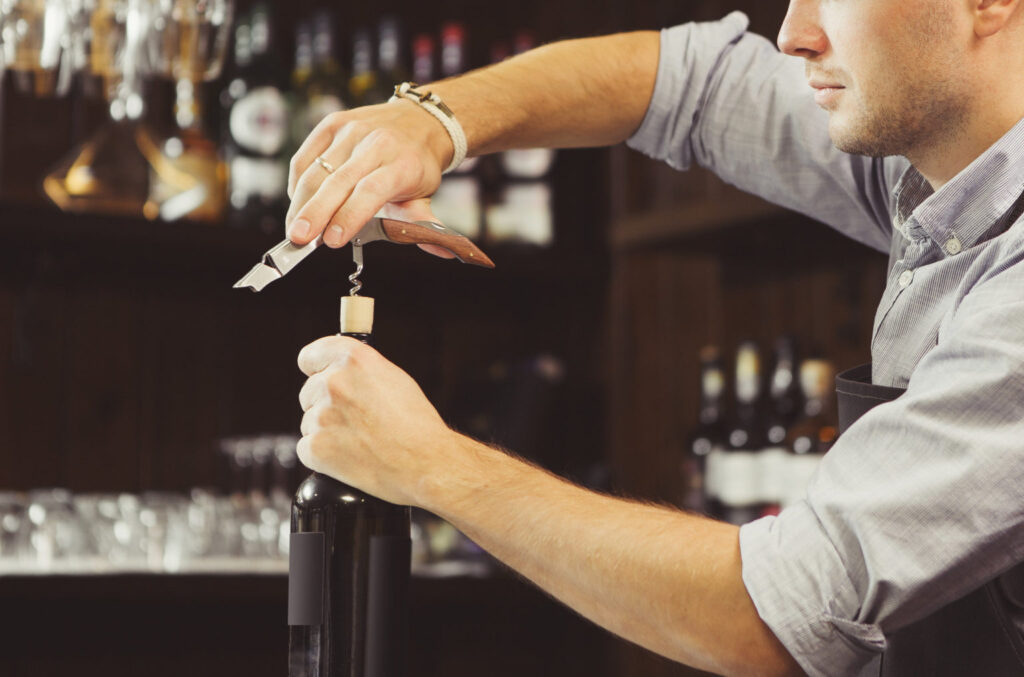
The next step is to twist the corkscrew, making sure to keep the worm in the center of the cork and to insert it straight down until only a single spiral loop shows at the top. These are the steps to follow:
- continue twisting until only one spiral of the screw is visible, typically requiring about 5-6 times,
- be careful not to screw all the way through the cork to avoid any cork particles ending up in the wine,
- if you don’t twist far enough, the cork might break into two pieces when you try to remove it.
Step 4. Leverage the cork out
To pull out the cork, position the corkscrew’s screw just off-center in the center of the cork. Then, use leverage to gradually ease the cork out by using a gentle twisting motion and pulling upward on the corkscrew handle. Most corkscrews have two small ridges on the inside of the lever arm.
Put the ridge closest to the hinge over the lip of the bottle and pull the handle up. This creates leverage to lift the cork. If the cork doesn’t come out enough, try using the other ridge further from the hinge on the bottle’s lip. Keep repeating this process if needed. If the cork is still stuck, make sure you’ve twisted the corkscrew enough.
Remember to keep a firm grip on both the bottle and corkscrew throughout this process.
Pull the cork out delicately. As you near completion, maintain control over the cork to avoid any sudden popping or uncontrolled release of pressure from inside the bottle.
Once the cork is removed, smell it to check for any off smells such as TCA (cork taint). Or not, this could be considered pretentious and ridiculous if you’re not certain you know what you’re doing.
Remove the cork from the bottle opener and put it on the side or, ideally, on a small plate. This is done so that the guests can examine the cork if they want, to make sure it’s wet on the side that was in the bottle and dry on the outer end.
Once the cork is removed, wipe the neck of the bottle to remove any debris or cork particles before serving the wine.
Step 5. Final touch

The sommelier is always the first to taste, so pour a small amount of wine into the glass to check the aromatic profile and quality of the wine. If the wine is corked, you would want to know that before pouring the wine into your guest’s glasses.
Hopefully, the wine is just as you imagined, and you and your guests can discuss the aromas and flavours.
Pour the wine slowly and steadily into the glass, aiming for the center of the bowl. The amount of wine you pour will depend on the size of the glass. As a general rule, a standard serving of wine is around 5 ounces (150 mL), which is about one-third of the glass.
Even the shiest people who are afraid to talk about wines (because they don’t know enough or aren’t familiar with the common vocabulary) are most likely to engage in a wine conversation after you devote so much effort to presenting the wines like a professional.
Of course, there are exceptions to these five steps, and the most notable exception would be the famous decanting.
Decanting is a technique used for the purpose of allowing the wine to breathe. How to choose the wine decanter, when to use it, and when not to use a decanter, is another story. And it is also a matter of which aspects of the wine you prefer to emphasize.
FAQs about how to open a bottle of wine
Q1. How do I start opening a wine bottle?
First off, grab your wine opener – preferably, a waiter’s friend corkscrew for its versatility and efficiency. Begin by removing the foil cap to access the cork, showing that you’re on track to enjoying your wine.
Q2. What’s the right way to insert the corkscrew?
Hold the neck of the bottle firmly with one hand while centering your corkscrew atop the cork with your other hand. Twist gently but firmly until you’ve pierced deep enough — about three-quarters into the cork. It’s all about control, ensuring nothing goes awry during this delicate stage.
Q3. How do I properly pull out the cork?
This is where it gets exciting! With a firm grip on both bottle and opener, use leverage from your wing or waiter’s corkscrew – whichever tool you’re wielding – to carefully lift out that stubborn cork. You might have to wiggle it back and forth just a touch as it comes free… And voila! The sound of popping cork is music to any wine lover’s ears.
Q4. Is there an alternative method if I don’t have a traditional corkscrew?
Indeed, when in a pinch — say at a picnic or impromptu gathering — getting creative becomes necessary! Opening wine without a corkscrew might seem daunting; however, methods using shoes for shock absorption or utilizing tools like screw caps offer makeshift solutions.
Q5. Why bother decanting my wine after opening?
Decanting isn’t just for show; it serves multiple purposes—oxygenating more robust, full-bodied wines and separating older vintages from settled sediments, thereby enhancing aromas and flavors deserving of those precious terroirs’ efforts through each harvest season at wineries worldwide.
Q6. What are some common mistakes when uncorking wine––and how can I avoid them?
Common pitfalls include breaking seals improperly, causing cork taint, and struggling with extraction due to incorrect insertion techniques, among others. Always start by cutting around foil cleanly, ensure always twist corkscrews straight down, leverage tools effectively, keep steady hands–-and most importantly: practice patience. Remember: every opened bottle provides learning opportunities, paving the way toward becoming an adept connoisseur over time.
Conclusion
Ready to open a bottle of wine like a pro? Gather the tools: waiter-style corkscrew and foil cutter. Present the bottle, remove the foil, and insert the corkscrew. Pull out the cork and pour the wine.
Remember to handle vintage wines delicately.


